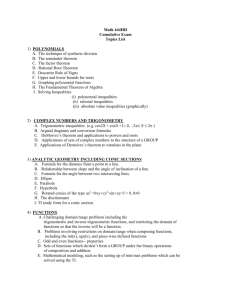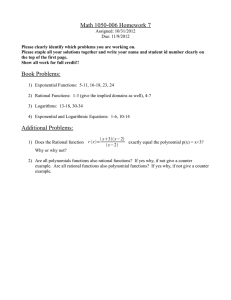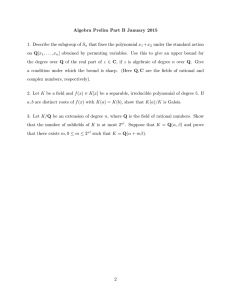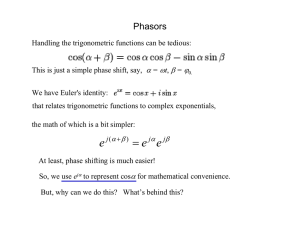Introductions to limits
advertisement
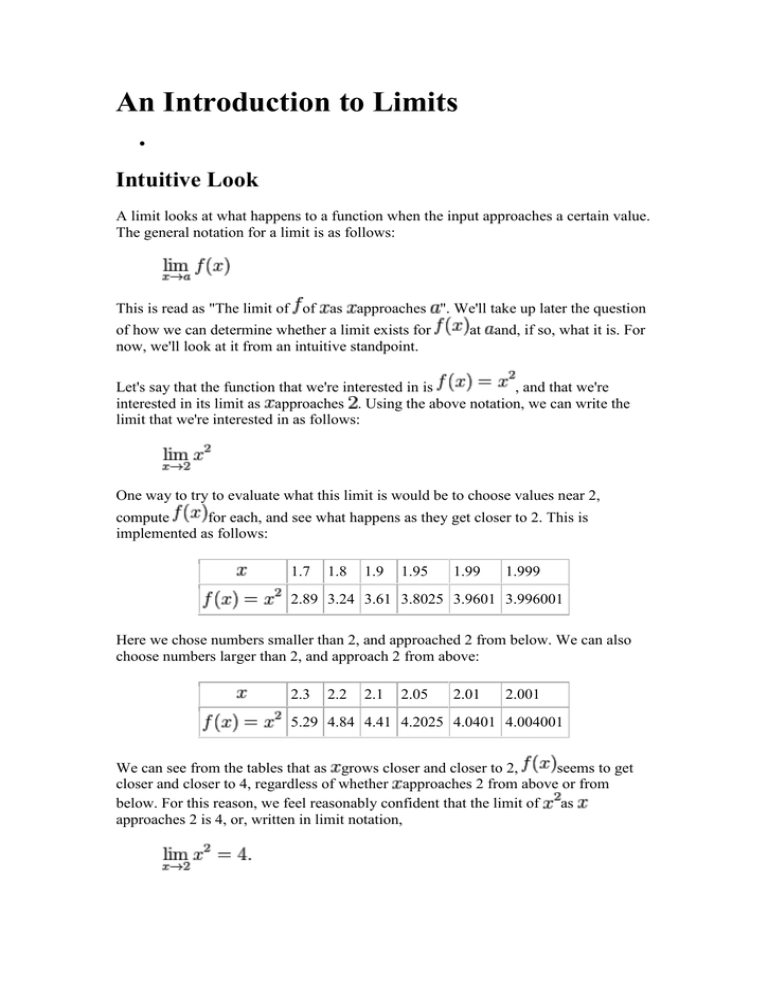
An Introduction to Limits Intuitive Look A limit looks at what happens to a function when the input approaches a certain value. The general notation for a limit is as follows: This is read as "The limit of of as approaches ". We'll take up later the question of how we can determine whether a limit exists for now, we'll look at it from an intuitive standpoint. at and, if so, what it is. For Let's say that the function that we're interested in is , and that we're interested in its limit as approaches . Using the above notation, we can write the limit that we're interested in as follows: One way to try to evaluate what this limit is would be to choose values near 2, compute for each, and see what happens as they get closer to 2. This is implemented as follows: 1.7 1.8 1.9 1.95 1.99 1.999 2.89 3.24 3.61 3.8025 3.9601 3.996001 Here we chose numbers smaller than 2, and approached 2 from below. We can also choose numbers larger than 2, and approach 2 from above: 2.3 2.2 2.1 2.05 2.01 2.001 5.29 4.84 4.41 4.2025 4.0401 4.004001 We can see from the tables that as grows closer and closer to 2, seems to get closer and closer to 4, regardless of whether approaches 2 from above or from below. For this reason, we feel reasonably confident that the limit of as approaches 2 is 4, or, written in limit notation, We could have also just substituted 2 into will not work with all limits. and evaluated: . However, this Now let's look at another example. Suppose we're interested in the behavior of the function as approaches 2. Here's the limit in limit notation: Just as before, we can compute function values as approaches 2 from below and from above. Here's a table, approaching from below: 1.7 1.8 1.9 1.95 1.99 1.999 -3.333 -5 -10 -20 -100 -1000 And here from above: 2.3 2.2 2.1 2.05 2.01 2.001 3.333 5 10 20 100 1000 In this case, the function doesn't seem to be approaching a single value as approaches 2, but instead becomes an extremely large positive or negative number (depending on the direction of approach). This is known as an infinite limit. Note that we cannot just substitute 2 into and evaluate as we could with the first example, since we would be dividing by 0. Both of these examples may seem trivial, but consider the following function: This function is the same as Note that these functions are really completely identical; not just "almost the same," but actually, in terms of the definition of a function, completely the same; they give exactly the same output for every input. In elementary algebra, a typical apporach is to simply say that we can cancel the term , and then we have the function . However, that would be inaccurate; the function that we have now is not really the same as the one we started with, because it is defined when , and our original function was specifically not defined when . This may seem like a minor point, but from making this kind of assumptions we can easily derive abusrd results, such that (see Mathematial Fallacy § All numbers equal all other numbers in Wikipedia for a complete example). Even without calculus we can avoid this error by stating that: In calculus, we can introduce a more intuitive and also correct way of looking at this type of function. What we want is to be able to say that, although the function isn't defined when , it works almost as if it was. It may not get there, but it gets really, really close. For instance, we have is: what do we mean by "close"? . The only question that Informal Definition of a Limit As the precise definition of a limit is a bit technical, it is easier to start with an informal definition; we'll explain the formal definition later. We suppose that a function is defined for near (but we do not require that it be defined when ). Definition: (Informal definition of a limit) We call the limit of as approaches if becomes close to when is close (but not equal) to , and if there is no other value with the same property.. When this holds we write or Notice that the definition of a limit is not concerned with the value of (which may exist or may not). All we care about are the values of is close to , on either the left or the right (i.e. less or greater). Limit Rules when when Now that we have defined, informally, what a limit is, we will list some rules that are useful for working with and computing limits. You will be able to prove all these once we formally define the fundamental concept of the limit of a function. First, the constant rule states that if (that is, is constant for all ) then the limit as approaches must be equal to . In other words Constant Rule for Limits If b and c are constants then . Example: Second, the identity rule states that if (that is, just gives back whatever number you put in) then the limit of as approaches is equal to . That is, Identity Rule for Limits If c is a constant then . Example: The next few rules tell us how, given the values of some limits, to compute others. Operational Identities for Limits Suppose that and and that is constant. Then Notice that in the last rule we need to require that is not equal to zero (otherwise we would be dividing by zero which is an undefined operation). These rules are known as identities; they are the scalar product, sum, difference, product, and quotient rules for limits. (A scalar is a constant, and, when you multiply a function by a constant, we say that you are performing scalar multiplication.) Using these rules we can deduce another. Namely, using the rule for products many times we get that for a positive integer . This is called the power rule. Examples Example 1 Find the limit . We need to simplify the problem, since we have no rules about this expression by itself. We know from the identity rule above that . By the power rule, . Lastly, by the scalar multiplication rule, we get . Example 2 Find the limit . To do this informally, we split up the expression, once again, into its components. As above, . Also gives and . Adding these together . Example 3 Find the limit . From the previous example the limit of the numerator is The limit of the denominator is As the limit of the denominator is not equal to zero we can divide. This gives . . Example 4 Find the limit . We apply the same process here as we did in the previous set of examples; . We can evaluate each of these; and Thus, the answer is . Example 5 Find the limit . In this example, evaluating the result directly will result in a division by zero. While you can determine the answer experimentally, a mathematical solution is possible as well. First, the numerator is a polynomial that may be factored: Now, you can divide both the numerator and denominator by (x-2): Example 6 Find the limit . To evaluate this seemingly complex limit, we will need to recall some sine and cosine identities. We will also have to use two new facts. First, if is a trigonometric function (that is, one of sine, cosine, tangent, cotangent, secant or cosecant) and is defined at , then . Second, . This may be determined experimentally, or by applying L'Hôpital's rule, described later in the book. To evaluate the limit, recognize that can be multiplied by to obtain which, by our trig identities, is . So, multiply the top and bottom by . (This is allowed because it is identical to multiplying by one.) This is a standard trick for evaluating limits of fractions; multiply the numerator and the denominator by a carefully chosen expression which will make the expression simplify somehow. In this case, we should end up with: . Our next step should be to break this up into product rule. As mentioned above, Next, by the . . Thus, by multiplying these two results, we obtain 0. We will now present an amazingly useful result, even though we cannot prove it yet. We can find the limit at of any polynomial or rational function, as long as that rational function is defined at (so we are not dividing by zero). That is, must be in the domain of the function. Limits of Polynomials and Rational functions If is a polynomial or rational function that is defined at then We already learned this for trigonometric functions, so we see that it is easy to find limits of polynomial, rational or trigonometric functions wherever they are defined. In fact, this is true even for combinations of these functions; thus, for example, . The Squeeze Theorem Graph showing being squeezed between and The Squeeze Theorem is very important in calculus, where it is typically used to find the limit of a function by comparison with two other functions whose limits are known. It is called the Squeeze Theorem because it refers to a function whose values are squeezed between the values of two other functions and , both of which have the same limit . If the value of is trapped between the values of the two functions and , the values of must also approach . Expressed more precisely: Theorem: (Squeeze Theorem) Suppose that holds for all in some open interval containing , except possibly at Then itself. Suppose also that also. . Plot of x*sin(1/x) for -0.5 < x <0.5 Example: Compute . Note that the sine of any real number is in the interval . That is, for all , and for all . If is positive, we can multiply these inequalities by and get . If is negative, we can similarly multiply the inequalities by the positive number and get . Putting these together, we can see that, for all nonzero , that . But it's easy to see . So, by the Squeeze Theorem, . Finding Limits Now, we will discuss how, in practice, to find limits. First, if the function can be built out of rational, trigonometric, logarithmic and exponential functions, then if a number is in the domain of the function, then the limit at is simply the value of the function at . If is not in the domain of the function, then in many cases (as with rational functions) the domain of the function includes all the points near , but not itself. An example would be if we wanted to find numbers besides 0. In that case, in order to find , where the domain includes all we want to find a function similar to , except with the hole at filled in. The limits of and will be the same, as can be seen from the definition of a limit. By definition, the limit depends on only at the points where is close to but not equal to it, so the limit at does not depend on the value of the function at . Therefore, if , also. And since the domain of our new function includes , we can now (assuming is still built out of rational, trigonometric, logarithmic and exponential functions) just evaluate it at as before. Thus we have . In our example, this is easy; canceling the 's gives , which equals at all points except 0. Thus, we have . In general, when computing limits of rational functions, it's a good idea to look for common factors in the numerator and denominator. Lastly, note that the limit might not exist at all. There are a number of ways in which this can occur: "Gap" There is a gap (not just a single point) where the function is not defined. As an example, in does not exist when . There is no way to "approach" the middle of the graph. Note that the function also has no limit at the endpoints of the two curves generated (at and ). For the limit to exist, the point must be approachable from both the left and the right. Note also that there is no limit at a totally isolated point on a graph. "Jump" If the graph suddenly jumps to a different level, there is no limit at the point of the jump. For example, let be the greatest integer integer, when approaches from the right approaches from the left A graph of 1/(x2) on the interval [-2,2]. . Thus . Then, if is an , while when will not exist. Vertical asymptote In the graph gets arbitrarily high as it approaches 0, so there is no limit. (In this case we sometimes say the limit is infinite; see the next section.) A graph of sin(1/x) on the interval (0,1/π]. Infinite oscillation These next two can be tricky to visualize. In this one, we mean that a graph continually rises above and falls below a horizontal line. In fact, it does this infinitely often as you approach a certain -value. This often means that there is no limit, as the graph never approaches a particular value. However, if the height (and depth) of each oscillation diminishes as the graph approaches the -value, so that the oscillations get arbitrarily smaller, then there might actually be a limit. The use of oscillation naturally calls to mind the trigonometric functions. An example of a trigonometric function that does not have a limit as approaches 0 is As gets closer to 0 the function keeps oscillating between and 1. In fact, oscillates an infinite number of times on the interval between 0 and any positive value of . The sine function is equal to zero whenever , where is a positive integer. Between every two integers , goes back and forth between 0 and or 0 and 1. Hence, for every . In between consecutive pairs of these values, and , goes back and forth from 0, to either or 1 and back to 0. We may also observe that there are an infinite number of such pairs, and they are all between 0 and . There are a finite number of such pairs between any positive value of and , so there must be infinitely many between any positive value of and 0. From our reasoning we may conclude that, as approaches 0 from the right, the function approach any specific value. Thus, does not does not exist. Using Limit Notation to Describe Asymptotes Now consider the function What is the limit as approaches zero? The value of defined. Notice, also, that we can make does not exist; it is not as large as we like, by choosing a small , as long as . For example, to make Thus, does not exist. equal to However, we do know something about what happens to , we choose to be . when gets close to 0 without reaching it. We want to say we can make arbitrarily large (as large as we like) by taking to be sufficiently close to zero, but not equal to zero. We express this symbolically as follows: Note that the limit does not exist at ; for a limit, being existing. In general, we make the following definition. is a special kind of not Definition: Informal definition of a limit being We say the limit of as approaches is infinity if big as we like) when is close (but not equal) to . becomes very big (as In this case we write or . Similarly, we say the limit of as approaches is negative infinity if becomes very negative when is close (but not equal) to . In this case we write or . An example of the second half of the definition would be that .


